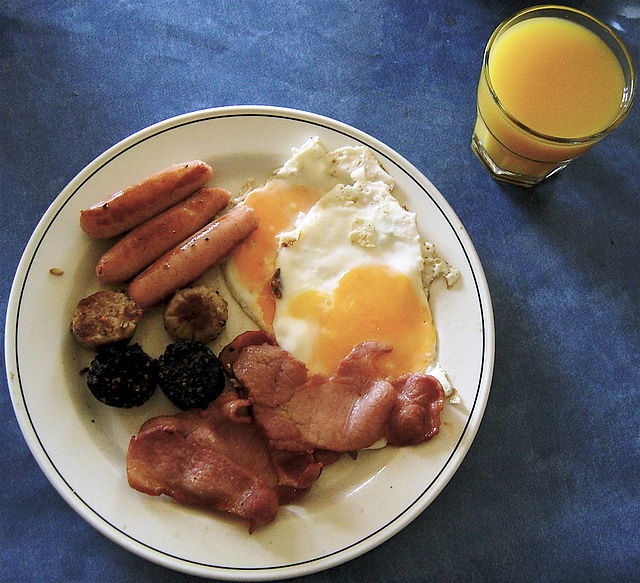Speaking of ‘ispíní” and other breakfast foods in Irish Posted by róislín on Aug 25, 2014 in Irish Language
(le Róislín)

Bricfeasta Éireannach (http://commons.wikimedia.org/wiki/File:Irish_breakfast.jpg#mediaviewer/File:Irish_breakfast.jpg)
I’ll take “an tsiosarnach” and “an t-ispín,” please. Trying to “have” my “císte” and eat it too, I guess. So, yes, although most of the time I try to have breakfast foods like iógart, múslaí, torthaí, and leite (le coirce “cruach-ghearrtha is fearr!), I have to admit I’m reasonably fond of the bricfeasta traidisiúnta. Here are the typical elements of the typical bricfeasta friochta:
uibheacha: de ghnáth bíonn siad “friochta,” ach amanna is féidir iad a fháil “scallta” nó “bogbhruite” nó “scrofa” má iarrann tú mar sin iad. Cén dóigh is fearr leat iad?
bagún: fairly self-explanatory, although it’s quite different in “uigeacht” from the bacon strips sold in the U.S.
ispíní: sausages. Remember, we briefly compared putóga to ispíní in the blog of 21 Lúnasa 2014 (nasc thíos)?
putóg dhubh agus putóg bhán: as we well know by now. I probably should have mentioned that these are generally served cut in round slices. It’s the uncut or whole “putóg,” before slicing, that’s really “ispínchruthach” [ISH-peen-KHRUH-hukh]. Hmm, “ispínchruthach?” The “cruth” [kruh, silent t] part means “shape,” so this word is patterned in the same way as t-chruthach, u-chruthach, v-chruthach, réaltchruthach, and ubhchruthach [UV-KHRUH-hukh]. An chuid sin “-chruthach” — what a great way to make compound words! We could even postulate ” *crwthchruthach,” to be a bit hybrid-ish about it (since there’s no Irish word for “crwth,” fad m’eolais, although “cruit” is related). And it would be reasonably useful, wouldn’t it, in contrast to “fidilchruthach“? For example, if we were discussing the history and construction of stringed instruments. But yes, I digress, when I really want to digest (“díleá” i nGaeilge).
trátaí friochta, although I would rather have “trátaí amha,” and can usually get them that way if I ask
muisiriúin fhriochta (lenition / séimhiú because “muisiriúin” ends in a slender consonant)
Sometimes there is also “arán friochta,” which I usually decline, since there’s almost always plenty of “tósta” as well as “arán donn” (neam!).
Many Americans are also surprised to find “pónairí bácáilte” as part of the “bricfeasta,” and it seems to me that that’s somewhat more typical i Sasana as opposed to in Éirinn. But perhaps some readers could weigh in on that matter.
And, now, before we end this blog, and I run “go dtí an chistin” (or “an chisteanach,” más fearr leat), agus ocras an domhain orm, what was all that about “sizzling” at the beginning of the blog? Simply an extension of Elmer Wheeler’s now classic adage, presented here in Irish, probably for the first time:
Ná díol an stéig — díol an tsiosarnach!
He apparently first wrote it as two direct commands (an modh ordaitheach, for móidíní na gramadaí!): Don’t sell the steak — sell the sizzle!
And actually there’s an interesting twist to all that, one that Wheeler himself couldn’t have predicted (fad m’eolais). “Stéig” has several meanings in Irish, with “steak” probably being the one most frequently encountered these days. But it also means … “intestine.” Not only does that suggest a different message altogether, but it also overlaps with the second major meaning of “putóg.” Remember the slisíní de phutóga dubha agus de phutóga bána, iad ag siosarnach sa fhriochtán agus ag glioscarnach ar an bpláta, iad te, blasta, agus dea-bhlasta, más beagán gréisceach atá siad leis? Well, “putóg” also means “intestine,” not surprising when we consider the origins of sausage casing. So now you know why sweet puddings, like chocolate or Swiss apple, aren’t called “putóga.” Bhuel, tá sé in am dom an blag seo a chur ina chásáil féin agus slán (agus “Bíodh goile maith agat”) a rá go dtí an chéad uair eile. – Róislín
PS: Cén Ghaeilge atá ar “pinhead”? Meas tú? And why am I even asking? Ní ag caint faoi aingil atá mé. How does “pinhead” relate to this blog? Comhghairdeas don chéad duine a scríobhanns isteach leis an míniúchán. Agus b’fhéidir “whiff” ionadach de na hispíní atá á bhfriochadh i bhfriochtán mo shamhlaíochta. Mo léan, níl fíorispíní sa teach — fós!
Nasc: The Parameters of ‘Pudding’ (Putóg et al.) Posted on 21. Aug, 2014 by róislín in Irish Language (https://blogs.transparent.com/irish/the-parameters-of-pudding-putog-et-al/)

Build vocabulary, practice pronunciation, and more with Transparent Language Online. Available anytime, anywhere, on any device.




Comments:
Seán:
Pinhead = ‘Ceann Cipín’ b’fhéidir? 😉
Stíl leite nach ea?
róislín:
@Seán ‘Sea, is cineál leitean é “pinhead” (agus cineál coirce).
Agus “Ceann Cipín” chomh maith, mar a dúirt tú, aka “blockhead.”
GRMA as d’fhreagra, agus comhghairdeas — tusa an chéad duine a scríobh isteach anseo.
Don:
Míle buíochas Róislín, bíonn do bhlog thar a bheith suimiúil I gcónaí.
róislín:
@Don Go raibh maith agat, a Don (a Dhónail?),
Tá áthas orm go mbaineann tú sult as.